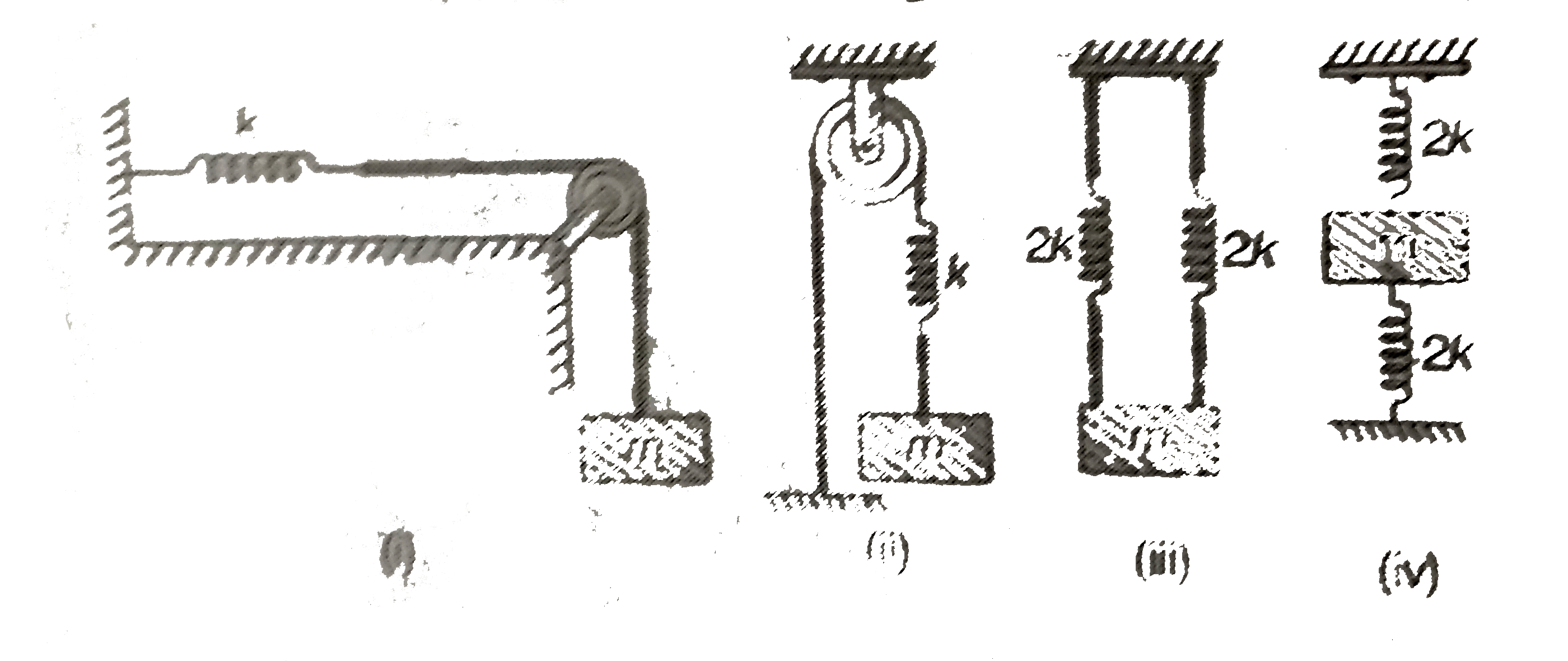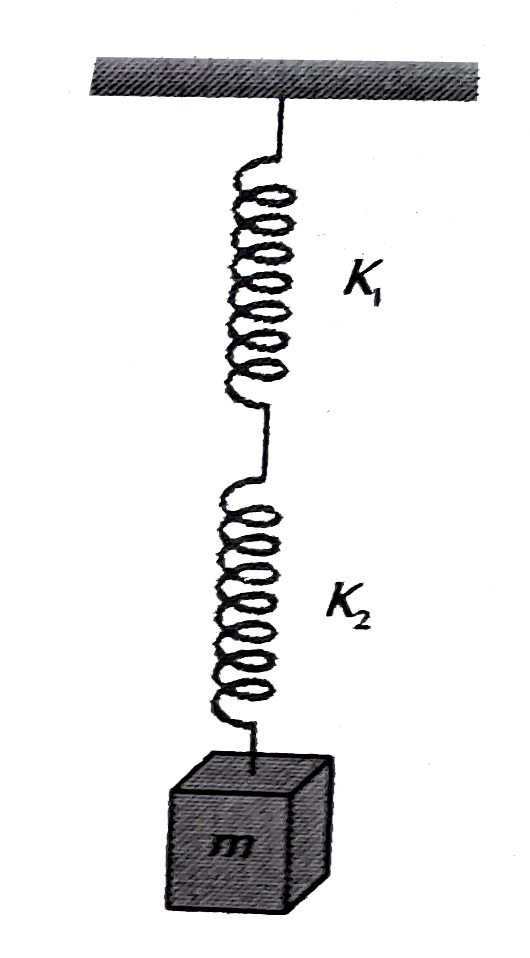A body of mass 'm' is suspended to an ideal spring of force constant 'k'. The expected change in the position of the body due to an additional force 'F' acting vertically downwards is
3F2K
2FK
5F2K
4FK
The correct Answer is:B
To solve the problem, we need to determine the change in the position of a mass 'm' suspended from a spring with force constant 'k' when an additional downward force 'F' is applied. We will analyze the system using the principles of equilibrium and energy conservation.
1. Understanding the Initial Setup:
- A mass 'm' is attached to a spring with spring constant 'k'.
- Initially, the mass causes the spring to stretch by a distance 'x' due to its weight (mg).
2. Finding the Initial Displacement (x):
- At equilibrium, the force exerted by the spring (spring force) equals the weight of the mass.
- The spring force can be expressed as Fspring=kx.
- Setting this equal to the weight of the mass, we have:
kx=mg
- Solving for 'x', we get:
x=mgk
3. Introducing the Additional Force (F):
- Now, when an additional force 'F' is applied downwards, the total downward force becomes mg+F.
- The new displacement of the spring, denoted as x′, can be found by setting the spring force equal to the new total weight:
kx′=mg+F
- Solving for x′, we have:
x′=mg+Fk
4. Calculating the Change in Position:
- We need to find the change in position of the mass due to the additional force, which is given by x′−x:
x′−x=(mg+Fk)−(mgk)
- Simplifying this expression:
x′−x=mg+F−mgk=Fk
5. Final Result:
- Therefore, the expected change in the position of the body due to the additional force 'F' acting vertically downwards is:
Δx=x′−x=Fk
Summary of the Solution:
The change in position of the mass due to the additional force is given by Δx=Fk.
---
- A mass 'm' is attached to a spring with spring constant 'k'.
- Initially, the mass causes the spring to stretch by a distance 'x' due to its weight (mg).
- At equilibrium, the force exerted by the spring (spring force) equals the weight of the mass.
- The spring force can be expressed as Fspring=kx.
- Setting this equal to the weight of the mass, we have:
kx=mg
- Solving for 'x', we get:
x=mgk
- Now, when an additional force 'F' is applied downwards, the total downward force becomes mg+F.
- The new displacement of the spring, denoted as x′, can be found by setting the spring force equal to the new total weight:
kx′=mg+F
- Solving for x′, we have:
x′=mg+Fk
- We need to find the change in position of the mass due to the additional force, which is given by x′−x:
x′−x=(mg+Fk)−(mgk)
- Simplifying this expression:
x′−x=mg+F−mgk=Fk
- Therefore, the expected change in the position of the body due to the additional force 'F' acting vertically downwards is:
Δx=x′−x=Fk
The change in position of the mass due to the additional force is given by Δx=Fk.
Topper's Solved these Questions
- BOOK - NARAYNACHAPTER - OSCILLATIONSEXERCISE - LEVEL -III51videos
OSCILLATIONS
- BOOK - NARAYNACHAPTER - OSCILLATIONSEXERCISE - NCERT BASED QUESTIONS1videos
OSCILLATIONS
- BOOK - NARAYNACHAPTER - OSCILLATIONSEXERCISE - LEVEL -I (C.W)34videos
OSCILLATIONS
- BOOK - NARAYNACHAPTER - NEWTONS LAWS OF MOTIONEXERCISE - PASSAGE TYPE QUESTION6videos
NEWTONS LAWS OF MOTION
- BOOK - NARAYNACHAPTER - PHYSICAL WORLDEXERCISE - C.U.Q10videos
PHYSICAL WORLD
Similar Questions
A body of mass 1 kg oscillates on a spring of force constant 16 N/m. Calculate the angular frequency.
View SolutionA body of mass 0.5 kg is suspended by a weightless spring of force constant 500 Nm−1. Another body of mass 0.1 kg moving vertically upwards with velocity of 5 ms−1 hits the suspended body and gets embeded into the suspended body. What will be the frequency of oscillation ?
View Solution
Knowledge Check
- Question 1 - Select One
A block of mass m is suspended by different springs of force constant shown in figure.
 AT1=T2=T4BT1=T2andT3=T4CT1=T2=T3DT1=T3 and T2=T4
AT1=T2=T4BT1=T2andT3=T4CT1=T2=T3DT1=T3 and T2=T4 - Question 2 - Select One
If a body of mass 0.98 kg is made to oscillate on a spring of force constant 4.84 N/m the angular frequency of the body is
A1.22 rad/sB2.22 rad/sC3.22 rad/sD4.22 rad/s - Question 3 - Select One
A body of mass 1 kg suspended by a light vertical spring of spring constant 100 N/m executes SHM. Its angular frequency and frequency are
A5π rad/s, 100 HzB10 rad/s, π5 HzC10 rad/s, 10π HzD10 rad/s, 5π Hz
A particle of mass m is hanging vertically by an ideal spring of force constant K . If the mass is made to oscillate vertically, its total energy is
View SolutionA block is suspended by an ideal spring of force constant force F and if maximum displacement of block from its initial mean position of rest is x0 then
View SolutionA number of forces acting on a body changes velocity of the body. The forces are
View SolutionA mass M is suspended by two springs of force constants K1andK2 respectively as shown in the diagram. The total elongation (stretch) of the two springs is
 View Solution
View SolutionTwo blocks of masses m1 and m2 are connected by an ideal sprit, of force constant k. The blocks are placed on smooth horizontal surface. A horizontal force F acts on the block m1. Initially spring is relaxed, both the blocks are at rest.

What is acceleration of centre of mass of system at the instant of maximum elongation of springView Solution

